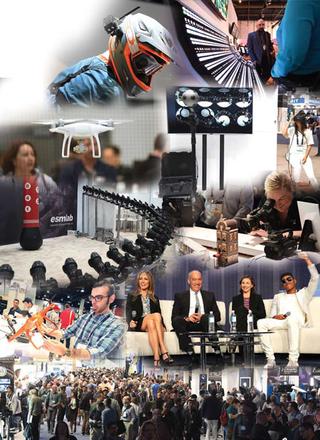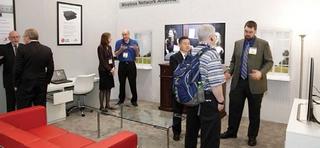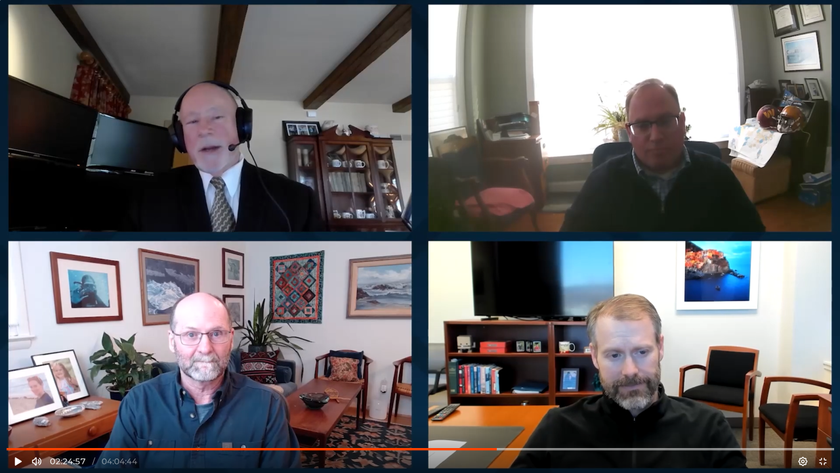Video Advances on Full Display at NAB Show
LAS VEGAS—Over the years, NAB has responded to the changing nature of its own annual convention by crafting a conference that better represents today’s current reality: a more diverse set of conference programs, an embrace of out-of-the-box technologies like social media curation and living room data analytics, and the cementing of new partnerships in its effort to help the industry navigate this new video path.

Convention organizers have addressed the show’s shifting demographic by drilling down to the challenges faced by this new audience mix, according to Chris Brown, executive vice president of conventions and business operations for NAB.
“The very definition of broadcasting is evolving, and this event, more than any other, provides the opportunity for participants from a variety of sectors to come together to explore the future of media,” he said.
Others offer a blunter assessment.
“NAB hasn’t been a broadcasters show for some time, at least, not since the end of the DTV transition in 2008 and 2009,” said Pete Putman, president of ROAM Consulting in Doylestown, Pa. “The ‘broadcaster’ part of NAB is very small now.”
Illustrating that the commonality outweighs the differences between various segments of the industry, this year’s show attempted to press the industry forward with sessions focused on the OTT landscape, virtual reality, new technologies driving live sports production, multiplatform advertising strategies, HDR and other next-gen video technologies.
NEXT-GEN TV
Perhaps the technology garnering the biggest double-takes is one that, coincidently, originates within broadcasting itself. The show touted a series of ATSC 3.0 demos designed to illustrate the possibilities behind the new standard.
A series of engineering sessions and demos were designed to “make as real as possible to opportunities inherent here,” said Mark Aitken, vice president of advanced technology at Sinclair Broadcast Group, who oversaw demos by ONE Media of the technology at the show.
At NAB, there were six areas of potential business opportunities for ATSC 3.0, including AWARN reporting, weather mapping and traffic information. Demos ran concurrent to sessions like “Single Frequency Networks Powering Broadcast’s Future,” which described how better pictures and sound are capable through single frequency networks.
“People were genuinely excited by the demonstrations that proved next generation television is about way more than just video and audio,” said Sam Matheny, executive vice president and chief technology officer for NAB. At the ATSC 3.0 Broadcast Pavilion at the South Hall, the association demonstrated a prototype ATSC 3.0 receiver and gateway option that would allow broadcasters to provide a richer and more customized experience for viewers, he said. “Beyond linear video and audio, the gateway showcased HTML 5 layout with on-demand access to weather, local station news stories, targeted content, interactive advertising, on-demand video, and real-time analytics,” Matheny said.
Just prior to the show, NAB filed a joint petition with the Consumer Technology Association, APTS and AWARN to allow broadcasters to voluntarily implement ATSC 3. FCC Chairman Tom Wheeler responded at the show by declaring that “ATSC 3.0 is significant,” adding that “we need to move with dispatch to get that into the public debate. I intend to put that out for public notice before the end of the month.”
Looking ahead, NAB plans to remain active in ATSC standards development through ongoing lab and field testing, according to Matheny.
Attendees were impressed as well. “The progress made and high level of interest in ATSC 3.0 [was impressive],” said Dave Siegler, vice president of Technical Operations for Cox Media. “It was great to actually see how that might work in the home and in the broadcast plant.”
Others, however—even those impressed with the technology—wonder if it’s too little too late.
“Is ATSC 3.0 too late? I guess we’ll have to wait for the spectrum auctions to conclude to see if broadcasters still feel there is value in terrestrial TV and if it’s worthwhile to take the next step,” said Putman, who added that NAB organizers did a disservice to the power of the ATSC 3.0 demo “by placing it all the way in the back of the upper south hall where not many attendees venture.”

The ATSC 3.0 Pavilion in the South Hall hosted a range of companies demonstrating the capabilities of the next-generation broadcast TV standard.MARRYING BROADCAST WITH IP
The show focused on a number of other trends, from HDR and 4K to drones for newsgathering and the transition of broadcast plants from SDI to IP. Siegler is one broadcaster looking closely at the intersection of ASTC 3.0 and IP and how that might fit into his stations’ facilities. “With ATSC 3.0, being IP-based, comes the opportunity to better merge our digital and broadcast workflows into one; this will be a major advancement to turn content around faster and more efficiently,” he said.
“Even ATSC 3.0 has an IP-centric leg to it,” Putman said. “There was a very IP-centric focus to NAB this year—streaming, IP-based production workflows, cloud storage and delivery—that started a few years ago and is really picking up steam.”
Others were impressed with technology on display: HEVC H.265 encoding, large OLED display panels for monitoring and the increasing use of fine-pitch LEDs in large videowalls. “We’re starting to see more 8K demos and talk about 8K production,” Putman said. “That’s happening way more quickly than I expected.”
The show also offered a look at new IP-connected technologies, 4K professional gear, a plethora of cloud-based options and large-scale archiving options, among others.
As the industry looks to the second half of 2016, industry insiders say the focus must be on the ways that content creators can take advantage of shifts in price on both hardware and software solutions.
“Hardware continues to drop in price,” Putman said. “The profit isn’t in boxes as much as it is in software and managed services, which mirrors what’s happening in the world of consumer electronics.”
The industry must also keep an eye on the ways that streaming is impacting content consumption. “Streaming is picking up considerable headway at the expense of physical media,” Putman said. The consumer industry has already moved away from buying discs to instead streaming and downloading full HD and even Ultra HD content.
That same shift applies to programming delivery. “The same applies to linear, time-scheduled broadcasts/delivery of TV programs to on-demand,” he said. “These trends will greatly affect the production and delivery of TV shows and movies.”
Regulatory and political issues were also an important consideration this year. “Of course, the elephant in the room is the ongoing spectrum auction,” Putman said. “Will we lose 10 channels? Twelve? Fourteen? Will broadcasters show any interest in ATSC 3.0?
As the show continues to shift, broadcasters must be prepared to adjust to this moving marketplace by being nimble, flexible and open-minded to the rapid changes that are taking place.
“The whole world of broadcasting is shifting quickly,” Siegler said. “We need to frame our perspective as ‘content creators’ and ‘content distributors.’”
The 2017 NAB Show will take place in Las Vegas, April 22–27.
Get the TV Tech Newsletter
The professional video industry's #1 source for news, trends and product and tech information. Sign up below.
Susan Ashworth is the former editor of TV Technology. In addition to her work covering the broadcast television industry, she has served as editor of two housing finance magazines and written about topics as varied as education, radio, chess, music and sports. Outside of her life as a writer, she recently served as president of a local nonprofit organization supporting girls in baseball.













